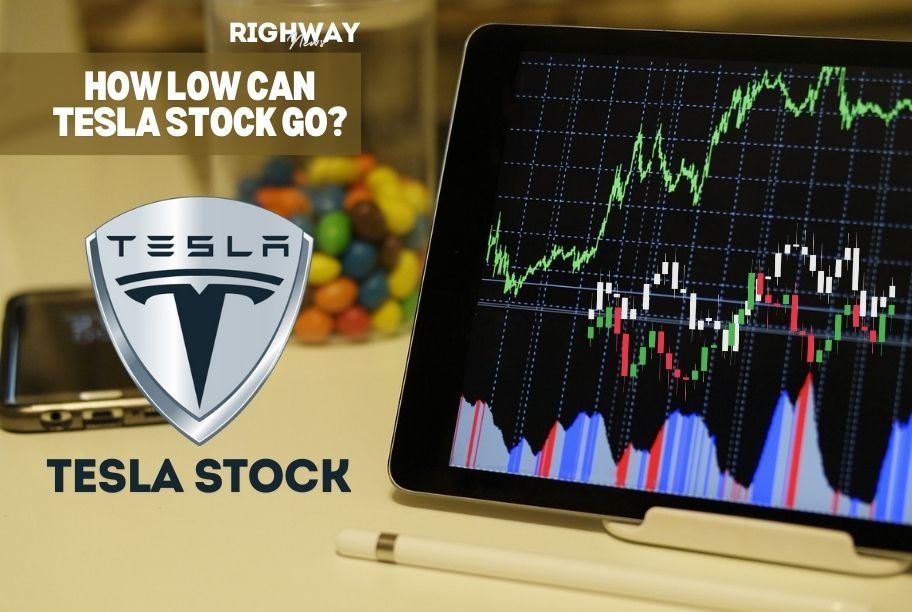Tesla Stock in Freefall: What’s the Lowest Point?
How Low Can Tesla Stock Go?
Tesla Inc. has consistently been at the center of debates among investors. The stock has experienced dramatic highs and devastating lows, prompting both excitement and anxiety within the market.
Thank you for reading this post, don't forget to subscribe!Recent developments in the electric vehicle (EV) sector, broader economic factors, and company-specific news have added to the speculation about Tesla’s stock trajectory.
This article delves into the latest insights, expert predictions, and in-depth analysis of how low Tesla stock could potentially go, considering current market trends and financial indicators.
Tesla stock has been on a rollercoaster ride. In the last few months, shares of Tesla have seen significant volatility.
After peaking at over $400 per share, Tesla’s stock price has experienced corrections, driven by various factors including market sentiment, global economic conditions, and company-specific news such as production updates and quarterly earnings.
Market Sentiment and Investor Behavior: The sentiment around Tesla stock is often driven by headlines and speculative news. For example, comments from CEO Elon Musk, new product announcements, or regulatory changes can cause substantial price swings.
Company Performance and Earnings Reports: Tesla’s quarterly earnings reports are closely scrutinized. Strong performance, such as meeting or exceeding delivery targets and financial forecasts, can bolster the stock. Conversely, any sign of underperformance can lead to a sell-off.
Technological Advancements and Product Innovations: Tesla’s position as a leader in the EV market is largely due to its technological advancements. Breakthroughs in battery technology, autonomous driving, and energy solutions play a crucial role in stock performance.
Global Economic Conditions: Broader economic conditions, including interest rates, inflation, and global supply chain issues, also impact Tesla’s stock. Economic downturns or crises can lead to reduced consumer spending, affecting Tesla’s sales and stock prices.
Competitive Landscape: The increasing competition in the EV market from companies like Rivian, Lucid Motors, and traditional automakers shifting to electric vehicles also influences investor perceptions and Tesla’s market position.
Some analysts maintain a bullish outlook on Tesla. They argue that the company’s innovation pipeline, brand loyalty, and expanding market presence will drive long-term growth.
Analysts at investment firms like ARK Invest have issued high price targets, based on Tesla’s potential in not just the EV market but also in energy storage and autonomous driving.
On the other hand, bearish analysts caution that Tesla’s high valuation is not sustainable. They point to potential over-reliance on future growth assumptions, regulatory risks, and the inherent volatility of the technology and automotive sectors.
Some market experts predict significant corrections if Tesla fails to meet high expectations consistently.


How Low Can Tesla Stock Go?
The question of how low Tesla stock can go is speculative but can be approached by analyzing historical performance, current financial health, and market conditions.
Historically, Tesla’s stock has seen corrections of over 30% from its peaks. For instance, in early 2021, the stock fell from around $880 to under $600 within a few months. Similar patterns have been observed in previous years, suggesting that substantial declines are not unprecedented.
Given the current economic environment, with rising interest rates and inflationary pressures, the stock market as a whole is experiencing turbulence. Tesla is no exception.
If the broader market enters a prolonged bearish phase, Tesla’s stock could see significant downward pressure.
Despite its high valuation, Tesla maintains strong financial health with substantial cash reserves and manageable debt levels.
However, traditional valuation metrics such as the Price-to-Earnings (P/E) ratio suggest that Tesla is trading at a premium compared to other automakers. If the market starts to favor value stocks over growth stocks, Tesla could experience a steeper decline.
Best-Case Scenario: In an optimistic scenario, Tesla continues to lead in innovation, achieves its production targets, and expands its market share globally. Under these conditions, Tesla’s stock might experience minor corrections but maintain an overall upward trajectory.
Moderate Scenario: In a moderate outlook, Tesla faces competition but continues to grow steadily. Market corrections might be more frequent, and the stock could experience periodic declines of 20-30%, stabilizing around $200-$250 per share based on current valuations.
Worst-case scenario: In the worst-case scenario, Tesla faces significant setbacks such as production issues, regulatory hurdles, or a major economic downturn.
Under these circumstances, Tesla’s stock could potentially drop below $150, considering historical correction patterns and market sentiment.
Tesla’s stock remains one of the most closely watched and debated in the market. While the company has shown remarkable growth and resilience, it is also subject to significant volatility.
Investors should consider both the potential for high returns and the risks associated with investing in a high-profile, high-volatility stock like Tesla.
Whether bullish or bearish, staying informed about the latest analysis and market trends is crucial for making sound investment decisions.
Why is Tesla’s stock so volatile?
Tesla’s stock is volatile due to high investor interest, frequent news and announcements, speculative trading, and the company’s significant impact on the future of the automotive and energy sectors.
What are the main risks associated with investing in Tesla?
The main risks include market volatility, high valuation, competitive pressures, regulatory challenges, and the company’s reliance on continuous innovation and execution.
How does Tesla’s valuation compare to other automakers?
Tesla’s valuation is significantly higher than traditional automakers based on metrics like the P/E ratio, reflecting investor expectations of high future growth and innovation.
Can Tesla stock reach new highs?
While Tesla stock can reach new highs, it depends on the company’s ability to meet growth expectations, innovate, and maintain its competitive edge in the market.
What should investors consider when deciding to buy or sell Tesla stock?
Investors should consider their risk tolerance, investment horizon, current market conditions, Tesla’s financial health, and industry trends before making investment decisions.
Have questions or need more information? Feel free to reach out to us through our Contact Page. You can also learn more about our mission and team on our About Page.
Stay connected with RIGHWAY on social media. Follow us on Facebook, Twitter/X, and Instagram for the latest news updates, behind-the-scenes content, and more. Engage with us online and be a part of our growing community.
Sign up for our newsletter to get the latest news delivered straight to your inbox. Follow us on social media for real-time updates and engaging content.
Stay connected with RighWay, where your news journey begins.
More like this Latest News
- EV Charging vs. Gas Prices: The Surprising Savings in 2024
- Surviving the COVID Summer Wave: Top Tips to Stay Safe
- Top 10 Peloton Instructors Who Will Transform Your Workout Routine
- What is the Bird Flu Pandemic?
- How to Treat Bee Sting Pain: Effective Remedies and Tips
- Lung Cancer: Can It Truly Be Cured?
- Types and Categories of Heart Health Supplements
- How Maye Musk’s flexitarian diet keeps her fit at 76
- Where is Uefa Euro 2024?
- Can Health Insurance Be Cancelled at Any Time?
- What Tony Awards Did Hamilton Win?
- What Will Tesla Stock Be Worth in 2025?
- NATO Countries Border Russia Amid Rising Tensions




